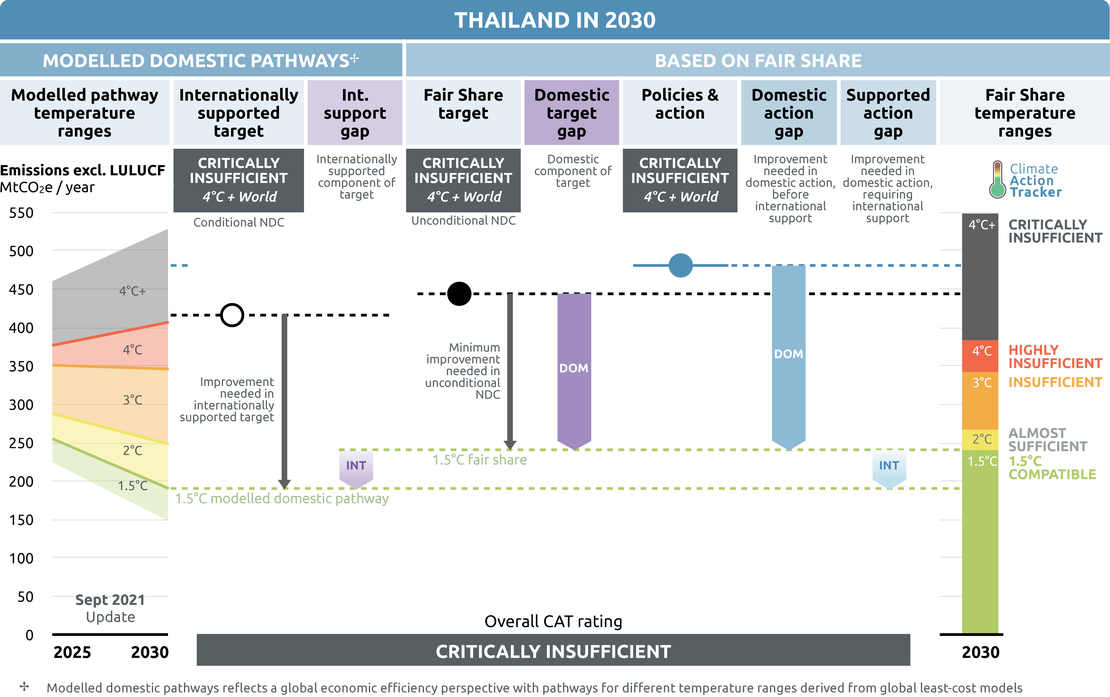Targets
Paris Agreement targets
NDC description
Thailand submitted its second NDC to the UNFCCC on 26 October 2020. It reiterates the 2015 NDC, including its unconditional GHG reduction target of 20% and a conditional target of 25% below BAU level by 2030, excluding LULUCF.
The CAT calculates that the unconditional target would lead to emission levels of 444 MtCO2e by 2030 excluding LULUCF, while the conditional target would lead to levels of 416 MtCO2e, also excluding emissions from LULUCF. To achieve its conditional target, Thailand indicates that it would require adequate and enhanced access to technology development and transfer, financial resources and capacity building support (Government of the Kingdom of Thailand, 2020b). The CAT rates Thailand’s internationally supported target and its fair share target as “Critically insufficient”.
We rate Thailand’s 2030 conditional and unconditional targets as “Critically insufficient”. The “Critically insufficient” rating indicates that Thailand’s internationally supported and fair share targets in 2030 reflects minimal mitigation action and is not at all consistent with the Paris Agreement’s 1.5°C temperature limit.
Thailand’s conditional and unconditional targets remain based on an inflated BAU that is significantly higher than its current and planned policy projections, even before the onset of COVID-19. Economic trends post-pandemic now lends even more weight to the possibility that the BAU is unrealistic and should be revised downward, with a corresponding strengthening of its emission reduction targets. If all countries were to follow Thailand’s current approach, warming would exceed 4°C.
Further information on how the CAT rates countries (against Modelled domestic pathways and Fair share) can be found here.
Last NDC update
Thailand’s updated NDC, submitted on 26 October 2020, is not an improvement on its first submission. It reiterates the 2015 NDC’s overall targets, including its unconditional GHG reduction target of 20% and a conditional target of 25% below BAU level by 2030 (Government of the Kingdom of Thailand, 2020b). The document, unlike the previous submission, provides no details on sectoral targets, although it has developed supporting implementation plans such as the NDC Roadmap on Mitigation and Supportive Action Plan.
The updated NDC notes that Thailand continues to 'explore the potentials' of bilateral, regional, and multilateral market-based cooperation, which could include the use of Article 6. One improvement in the updated NDC is Thailand’s exclusion of LULUCF from its NDC target (the First NDC stated that the inclusion of LULUCF in the target “will be decided later”), as it improves transparency in the target and highlights the need for action in other sectors. A separate target for LULUCF would further strengthen the NDC.
Net zero and other long-term target(s)
Thailand does not have a net zero target nor a long-term strategy (at the time of writing). However, the government is in the process of developing a long-term Low Greenhouse Gas Emission Development Strategy to help Thailand reach carbon neutrality (Ministry of Natural Resources and Environment, 2020b). The strategy and carbon neutrality is currently being elaborated, to be finalised ahead of COP26. The plan is expected to include a peak target, emissions reduction targets and a target year for carbon neutrality (Praiwan, 2021).
2020 pledge
The target of a GHG emissions reduction of 7-20% below BAU in the energy and transport sectors had been included in Thailand’s NAMAs and Climate Change Master Plan (Ministry of Natural Resources and Environment, 2014, 2015). The measures included mitigation actions in the energy and transport sectors.
The 3rd Biennial Update Report notes that in 2018, Thailand had achieved a GHG emissions reduction of 15.76% under its BAU (Ministry of Natural Resources and Environment, 2020b). The CAT calculates Thailand’s 2020 BAU reference to be 469 MtCO2e and its GHG emissions reduction targets to be 375 to 436 MtCO2e/year in 2020. According to CAT analysis, Thailand overachieved this goal due to the economic downturn caused by COVID-19, although it was on track to be within the range pre-COVID as well.
Further analysis
Latest publications
Stay informed
Subscribe to our newsletter







